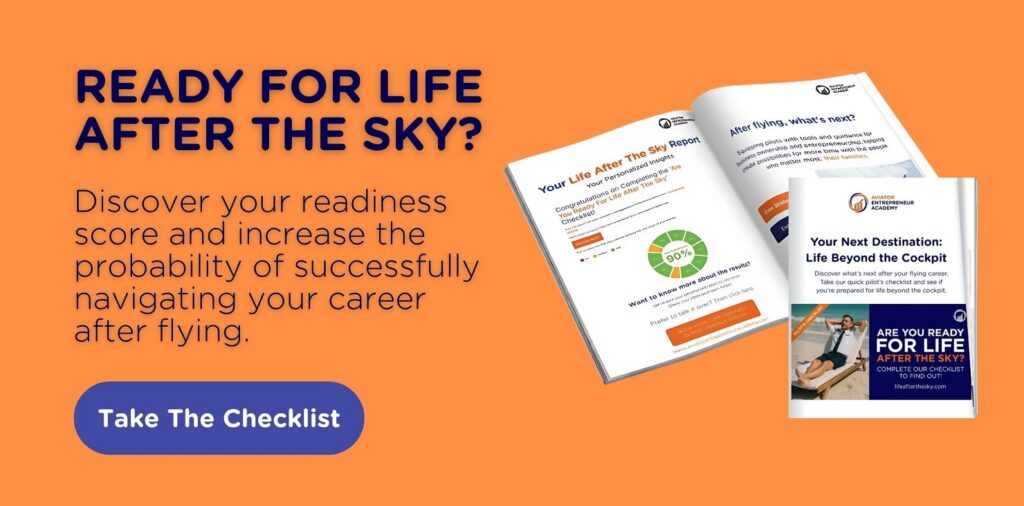You’ve logged thousands of hours, flown through storms, and made decisions most people can’t even imagine. Your wings weren’t handed to you; they were earned through discipline, sacrifice, and relentless training.
But the shocking part? These things don’t matter to clients in business. They don’t care how many flight hours you’ve logged or how many aircraft ratings you have.
All they care about is how their life, their team, or their business will look after working with you. If you lead with your credentials, you’ll sound impressive but forgettable.
So, what’s the solution? Let’s find out.
Key Takeaways
- The Credentials Trap: If you lead with your aviation background, customers tune out. They’re really just asking, “What’s in this for me?”
- What Actually Matters: People care about their future, not your past. Show them the transformation, solve their problems, reduce their risks, and prove the ROI.
- Transformation-First Approach: Talk about where your client will be after working with you. Then connect your aviation skills to outcomes they care about, in plain language.
- How to Apply It: Check your materials, rewrite your intro to lead with transformation, collect before-and-after client stories, and test it in real conversations.

The Credentials Trap
One of the biggest mistakes pilots make when transitioning into business is leading with their aviation background.
Surely that should win instant trust, right? WRONG.
Here’s how the introduction sounds to the customers:
“I have lots of experience in an industry unrelated to your problems. I’ll probably charge a lot because I think my background is impressive.”
Psychology research consistently shows that people filter every conversation through the lens of self-interest. Consciously or not, they are always asking, “What’s in this for me?”
This doesn’t mean your credentials don’t matter; they do.
However, they only matter when they directly connect to the customer’s transformation.
As Dale Carnegie, author of How to Win Friends and Influence People, put it: “Talk to someone about themselves and they’ll listen for hours.”
What Actually Matters to Customers
At the end of the day, customers don’t buy your credentials. They buy what their life, business, or career will look like after working with you. That means your message has to connect with their deepest concerns and desires.
Here’s what they actually care about:
1. Future State Visualization
People want to see the transformation you’ll help them achieve clearly. Can you paint a picture of what their world looks like after working with you?
For example, instead of talking about your aviation background, describe how their business will finally run smoothly. When customers can visualize the finish line, they’re far more likely to say yes.
2. Problem Resolution Confidence
Credentials are just background noise unless they directly connect to solving the customer’s problem. What they really want is confidence that you understand their challenges and have a way to fix them.
The more specific and relevant your proof is, the stronger the connection it establishes. Instead of, “I have 20 years of experience,” say, “I’ve helped companies like yours cut operational errors in half within six months.”
That’s proof they can trust.
3. Risk Mitigation
Every purchase comes with fear. Fear of wasting money, losing time, or creating new problems. Customers need to know you’re a safe choice.
This is where real-world testimonials, success stories, and case studies become powerful. They take the risk off the table by showing others have already gotten results.
When customers see evidence that people like them have succeeded with you, their hesitation fades.
4. Return on Investment
Ultimately, customers must believe that the transformation is worth the price. This isn’t just about money; it’s about the trade-off of time, energy, and trust.
You must demonstrate to them that working with you will yield outcomes that far outweigh the cost. If you can position your service as an investment that pays back multiples in growth and peace of mind, you’ll win their attention.
The Transformation-First Approach
When people decide to buy, they don’t think about your flight hours or what aircraft you flew; they think about how their life or business will change.
As pilots, we can use our discipline and expertise, but the message must start with that transformation, not your credentials.
1. Start with Their Destination
Lead with what your customer wants, not what you have to offer.
Instead of saying, “I’ve flown in multiple continents,” say, “You’ll expand into new markets and grow revenues without costly regulatory surprises.”
Because when you show them the destination early, they settle faster on what value you bring.
2. Connect Expertise to Outcomes
It’s okay to use aviation experience, but only when it directly maps to outcomes they care about.
For instance, your experience managing crew coordination under high stress becomes “your team handles crises smoothly without panic.”
That’s the outcome, not just a story of what you did.
3. Speak Their Language
Translate aviation terms into a language that business clients can understand. Replace “crew resource management” with “team communication under pressure.”
Another example would be to swap “complex flight systems” for “operational reliability when it matters most.”
Simpler language builds trust and makes the transformation feel real.
4. Focus on Results
Proof strengthens everything. Talk about your past clients’ achievements: percent improvements, time saved, money gained.
For instance, research from Walker Sands shows that nearly 90% of marketing leaders prioritize measurable business outcomes over campaign metrics.
When you show real results, customers see risk decline and value becomes obvious.
How Do You Put Transformation First in Practice?
Knowing that customers care about transformation more than credentials is one thing. But how do you actually shift your positioning so they feel it in every interaction? That’s where a clear action plan, just like your flight plan, comes in.
1. Audit Your Materials
Go through your website, presentations, and introductions. Count how many sentences focus on your credentials versus how many highlight customer outcomes.
Most pilots find the balance is heavily skewed toward themselves. That’s where this audit will expose the gap.
2. Rewrite Your Introduction
Start leading with transformation, not titles. Instead of opening with, “I’m a commercial pilot with 20 years of international flying,” try, “I help leaders make confident decisions under pressure and guide their teams smoothly through crises.”
That reframing puts the spotlight where it belongs, on the customers.
3. Create Transformation Stories
Build at least three before-and-after stories from client work.
Each should highlight the challenge they faced, the transformation they experienced, and the results they achieved.
These stories are far more persuasive than a list of credentials because they let prospects imagine themselves in the same success story.
4. Test and Measure
Put your new approach into action. Try it in sales calls, networking events, or even LinkedIn posts. Watch for differences in response.
For instance, do people lean in? Ask follow-up questions? Or want to know more?
Tracking reactions helps refine your messaging and proves that transformation-focused communication drives better results.
Stop Selling Credentials, Start Selling Transformation
At the end of the day, your credentials are not the reason clients say “yes.” They may respect your aviation hours, but what truly matters to them is how you can solve their problems and get them to their destination with fewer mistakes.
Customers don’t buy resumes; they buy results. However, if you feel like you’re not ready to jump into business just yet, we’ve got something for you.
Take out just 3 minutes to complete our Life After The Sky checklist. And you’ll know exactly where you stand today and the steps you need to take to move forward.
Invitation to Join Our FREE Strategy Session
Most pilots are one honest conversation away from clarity. This is that conversation.
Complete our “Life After The Sky” checklist, then join me for a FREE 15-minute “Strategy Session” via Zoom.
This session has been created for pilots who want to take ownership of what comes next.
Those who want action, not just to talk about it.
In just 15 minutes, we’ll:
- Review your checklist results
- Identify the one obstacle holding back your reinvention
- Translate your checklist results into a clear starting point
Start your pre-flight assessment for the next chapter of your journey by Booking your free strategy session here!



